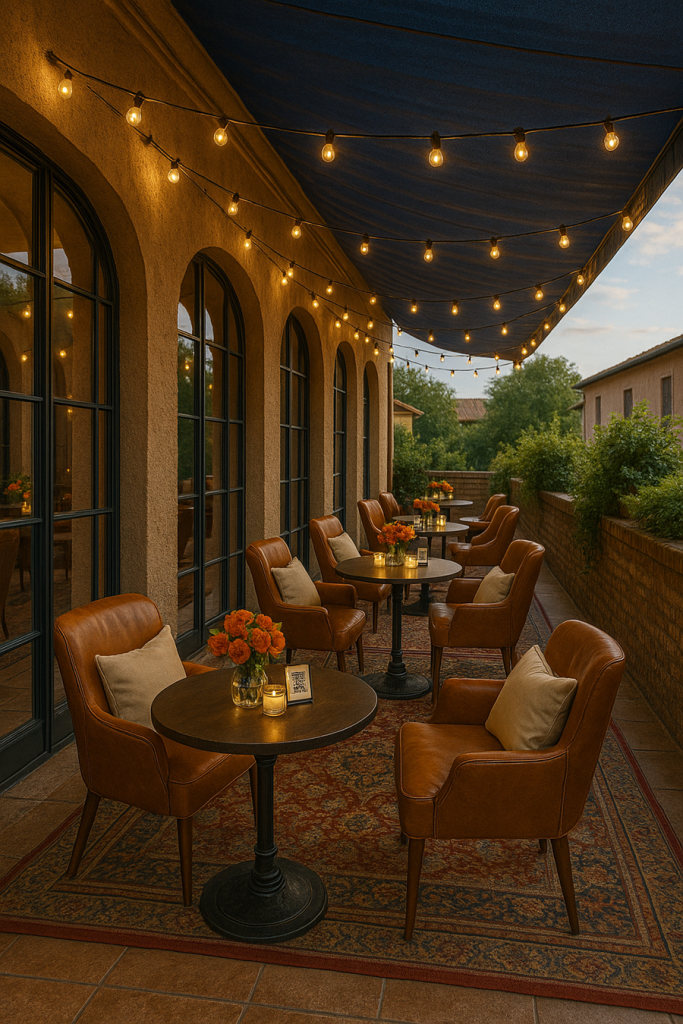So Close to Perfect, Yet So Far
Viennese Al Fresco Vibes — So Close to Perfect, Yet So Far

Imagine strolling into a sun-drenched patio where cozy two-tops and bright floors make you feel like you’re starring in a European summer movie. Everything looks inviting. And yet — little cracks in the design psychology are quietly costing sales, loyalty, and evening energy. Let’s decode what’s happening beneath the surface.
What They Absolutely Nailed
Small Round Tables Outside
- Behavioral Principle: Cognitive Control & Interpersonal Distance (Edward T. Hall)
- Why It Works: Small, circular tables create a sense of intimacy and safety. Guests naturally relax, chat longer, and — crucially — order that second coffee or dessert.
Abundant Natural Light and Bright Flooring
- Behavioral Principle: Serotonin Activation via Natural Light
- Why It Works: Bright spaces trigger serotonin production, boosting mood, appetite, and decision-making positivity. Bonus: Light-reflective floors amplify this feel-good glow, making everything seem bigger and cleaner.
Where Things Start to Fall Apart
Metallic Chairs of Doom
- Behavioral Principle: Affective Forecasting Error (Gilbert et al., 1998)
- Why It Hurts: Guests subconsciously predict discomfort just by looking at hard, cushionless metal chairs. The result? Shorter stays, faster exits, fewer second-round orders.
Stone Floors — Textural Turn-Off
- Behavioral Principle: Sensory Perception & Texture Priming
- Why It Hurts: Cold, hard surfaces send subtle “temporary” or “low-value” signals to the brain. Even a gorgeous space can feel emotionally “meh” because of it.
Lighting Mistakes That Dim the Magic
No Decorative or Ambient Lighting
- Behavioral Principle: Ambience Lighting Effect on Consumer Behavior (Baker et al., 1992)
- Why It Hurts: Natural light is a dream during the day — but once clouds roll in or sunset hits, the entire vibe collapses. Without string lights, candles, or warm pendants, the place can feel cold and abandoned.
- Quick Fix: Think fairy lights, soft table candles, or hanging bulbs at ~2700–3000K. Instant mood upgrade, no major construction needed.
Tabletop Troubles
Empty Tables = Empty Emotions
- Behavioral Principle: Priming Effect + Affective Forecasting
- Why It Hurts: Naked tables lack “emotional bait.” No flowers, candles, or playful menu inserts = lower perceived warmth, lower order volume.
- Quick Fix: Even a tiny vase, an unscented candle, or a welcoming tabletop menu could trigger a surge in emotional engagement.


Menu Mishaps

No Menus in Sight
- Behavioral Principle: Availability Heuristic (Tversky & Kahneman, 1973)
- Why It Hurts: If the brain doesn’t see food options immediately, the urgency to order plummets. No menu = no cravings = no second course.
- Quick Fix: Place small table menus or QR codes prominently. If they see it, they’ll crave it. If they crave it, they’ll order it. Psychology 101.
Slim Format Issue
- Behavioral Principle: Cognitive Fluency Theory
- Why It Hurts: Tall, narrow menus exhaust the eyes. Scanning up and down instead of side-to-side slows decision-making.
- Quick Fix: Break the menu into two or three columns to make scanning easier and faster.
Poor Chunking
- Behavioral Principle: Chunking Effect (George Miller, 1956)
- Why It Hurts: No clear categories like “Appetizers” or “Desserts”? Your guests’ brains are working way too hard. And tired brains don’t splurge.
- Quick Fix: Stronger, more visual section headers with size or color contrast.
No Charm Pricing
- Behavioral Principle: Charm Pricing Effect
- Why It Hurts: €17 feels heavier than €16.95, even if the logical difference is tiny. Humans process numbers emotionally first.
- Quick Fix: End prices in .95 or .99 to nudge up perceived value and affordability.
No Highlighted Item
- Behavioral Principle: Salience Bias
- Why It Hurts: If everything looks equal, nothing stands out. No visual shortcut = decision fatigue.
- Quick Fix: Star the most profitable dishes, add small icons, or subtly frame specials.
Flat Visual Hierarchy
- Behavioral Principle: Visual Hierarchy Theory
Why It Hurts: Identical fonts everywhere make everything blur together. The brain loves contrast to prioritize information.
Quick Fix: Bigger, bolder item names with smaller, softer-toned descriptions underneath.
In Conclusion, An Almost-Perfect Outdoor Dream Needing Just a Little Behavioral TLC
This patio already whispers “stay a while,” but with a few smart tweaks — comfy seating, layered lighting, sensory tabletop magic, menu redesigns, and charm pricing — it could shout “stay all day (and order a lot more).”
Picture This:
- 20% increase in late afternoon and evening sales
- Longer table occupancy without pressure
- More upselling opportunities from “menu-at-a-glance”
All without breaking the aesthetic charm.
Just my two neurons firing — you can disagree, but your guests’ brains might stage a quiet protest if you do.
Comments are closed